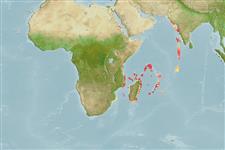Common names from other countries
Environment: milieu / climate zone / depth range / distribution range
Ecologia
marinhas; estuarina demersal. Tropical
Western Indian Ocean: Comoros, Madagascar, Seychelles and Mascarenes Islands.
Tamanho / Peso / Idade
Maturity: Lm ? range ? - ? cm
Max length : 10.0 cm TL macho/indeterminado; (Ref. 4342)
Facultative air-breathing (Ref. 126274); It is an amphibious blenny that inhabits exposed and moderately exposed rocky intertidal habitats (Refs. 120780, 130806). It is occasionally found in the mouths of rivers. The actual occurrence of this euryhaline species in freshwater is uncertain (Ref. 4342). It stays above the water line on moist or wet surfaces as it moves both vertically and horizontally with the tide. Feeds on emerged microscopic algae scraped from the rocks (Ref. 130806). Oviparous (Ref. 205). Eggs are demersal and adhesive (Ref. 205), and are attached to the substrate via a filamentous, adhesive pad or pedestal (Ref. 94114). Larvae are planktonic, often found in shallow, coastal waters (Ref. 94114).
Ciclo de vida ou comportamento de acasalamento
Maturities | Reprodução | Spawnings | Egg(s) | Fecundities | Larvas
Oviparous, with distinct pairing (Ref. 205).
Bath, H., 1986. Blenniidae. p. 355-357. In J. Daget, J.-P. Gosse and D.F.E. Thys van den Audenaerde (eds.) Check-list of the freshwater fishes of Africa (CLOFFA). ISNB, Brussels, MRAC, Tervuren; and ORSTOM, Paris. Vol. 2. (Ref. 4342)
Status na Lista Vermelha da UICN (Ref. 130435)
CITES (Ref. 128078)
Not Evaluated
Ameaça para os humanos
Harmless
Uso pelos humanos
Pescarias: sem interesse
Ferramentas
Relatórios especiais
Baixar XML
Fontes da internet
Estimates based on models
Preferred temperature (Ref.
115969): 25.4 - 28.9, mean 27.5 (based on 267 cells).
Índice de diversidade filogenética (Ref.
82804): PD
50 = 0.5010 [Uniqueness, from 0.5 = low to 2.0 = high].
Bayesian length-weight: a=0.01000 (0.00244 - 0.04107), b=3.04 (2.81 - 3.27), in cm Total Length, based on all LWR estimates for this body shape (Ref.
93245).
Nível Trófico (Ref.
69278): 2.0 ±0.00 se; based on food items.
Resiliência (Ref.
120179): Elevada, tempo mínimo de duplicação da população menor que 15 meses (Preliminary K or Fecundity.).
Fishing Vulnerability (Ref.
59153): Low vulnerability (10 of 100).
